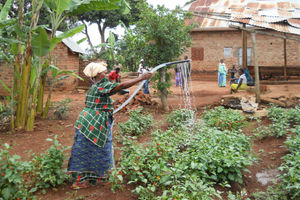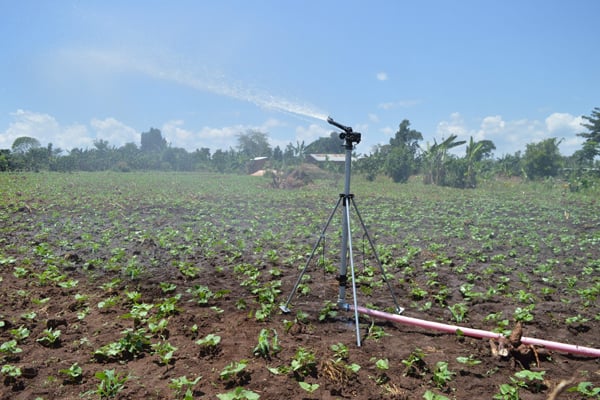
It is important for farmers to adopt irrigation methods by watering their crops during times of dry spell instead of relying on unreliable rainfall.
This means farmers can tailor the amount of water to use at a farm and at what time and amount for the crops to grow.
Irrigation can also reduce water loss on farmers’ field and farmers can also reduce evaporation by choosing irrigation methods that give smaller, steady amounts of water to your plants.
Lots of irrigation methods can be set up and left to irrigate your crops, meaning for you and more time to get other things done.
This is why irrigation has been widely seen to increase the quality and yield of crops.
Another big benefit of irrigation is not having to wait for the rains, with a water source near your farm you can keep growing crops all year round.
There are so many types of irrigation farmers can use in their farms depending on the type of soil, budget and water sources.
Sprinklers
This is one of the most popular types of irrigation we see on smallholder farms. They are affordable and very easy to use.
Sprinklers are attached to sections of the hose pipe with connectors and water is supplied by either a water pump or water tank. They are moved around the farm to evenly water all the crops.
Water droplets are ‘rained’ down in circles from sprinklers, so a lot of ground can be covered. However, as water is sent from a height to a wider area, it is not as efficient as other types of irrigation.
Sprinklers can be left to irrigate your crops until they need to be moved or stopped, giving the farmer more time to do other things such as farm work or a well-deserved rest.
Drip irrigation
We are seeing more and more drip irrigation used on smallholder farms and there is a good reason why it is one of the most efficient ways to irrigate your crops!
It is called drip as this method uses hose pipes with small holes or nozzles along it to drip feed water to the base of your plants.
These are known as drip lines and are laid along where your crops are planted. Water is usually supplied to the drip lines from tanks, using gravity to power the slow flow of the water. Water pumps are used to get water into the water tanks.
Drip is very efficient as water is slowly given to the base of your plants throughout the day, reducing over watering, evaporation and water loss. It also allows the farmers to do other things as you can leave it to irrigate.
Mist irrigation
Mist is less common on smallholder farms. It works by spraying a fine mist of water onto your crops.
It is similar in a way to drip, in that water is put through small holes or nozzles but at a higher pressure. This allows you to water quicker and a wider area, but it is less efficient.
Mist can be left to irrigate while farmers do other things but it also requires the purchase of equipment, such as a water tank or water pump, so it has higher start-up costs.
Manual irrigation
Manual irrigation is by far the most common form of irrigation as anyone physically able to, can manually irrigate their crops.
Manual irrigation is where farmers pour water from plant to plant. This is very labour intensive and is usually done with a hose or bucket, so it is only suitable for smaller areas.
These ways are also the least efficient as you have less control over the water and it is usually delivered in larger quantities that are not as good for the plant and can increase run-off from your farm.
Farrow irrigation
This is the practice of flooding the soil around the plants, sometimes using furrows between raised ridges where the plants grow.
This type of irrigation needs large amounts of water, usually supplied with a water pump. The farmer will need to plan and plant your crops with ridges and furrows.
It is quite an inefficient way to irrigate as pools of water will evaporate easily especially in warm, sunny conditions.
Plus with the large volumes of water farmer could lose some crops on the farm in run-off.
Innovative bottle sprinkler irrigation tool
In a publication gardening ideas about made in China farm products experts are advising farmers to make their own bottle.
This is an efficient and eco-friendly rotating irrigation sprinkler which is made by incorporating a mechanical bearing into the design to enhance the rotation mechanism for smoother operation and better durability.
This modification allows for a more reliable and effective irrigation system for the garden.
How farmers can build your own.
Required materials
The farmer will require to obtain two plastic bottles of 0.5 liter size
Have Poly Vinyl Chloride (PVC) polymer which is made from vinyl chloride connector with mouth slightly smaller than the mouth of the bottle.
One large PVC pipe to house the mechanical bearing, one smaller PVC pipe to pass through the bearing and PVC glue, water proof sealant or rubber seals and drill or sharp tools to make holes.
After obtaining the above materials, the farmer is expected to heat the PVC connector slightly for it to become flexible and carefully insert the plastic bottles into the ends ensuring a tight fit.
Drill or make a hole in the middle of each bottle pointing upwards for water to spray out and create another hole at the bottom side of each bottle for rotating mechanism. Ensure one bottle has the hole on one side and the other bottle on the opposite side for balance rotation
Constructing
Select a large PVC pipe that can comfortably accommodate the mechanical bearing. Glue the bearing inside one end of the pipe using PVC glue and make sure it is centered to ensure rotation.
Slide the smaller PVC pipe through the mechanical bearing and the pipe acts as the axis of rotation to enable free movement.
Seal both ends around the smaller pipe where it exists the larger pipe using water proof seal to prevent water leakage while rotating.
Assembly
Connect the garden hose to the bottom end of the smaller PVC pipe to serve as the vertical support and water supply line for the sprinkler.
Attach the PVC T section with the bottles to the top end of the smaller PVC pipe for rotation. The larger PVC pipe with the bearing should be fixed in place while the smaller pipe with the attached bottle T connector rotates within it
Turn on the water and adjust the flow to test the sprinkler’s rotation. The water pressure from the holes in the bottles will cause the assembly to spin, providing an even distribution of water across your garden.
Key fact
Drip is very efficient as water is slowly given to the base of your plants throughout the day, reducing over watering, evaporation and water loss. It also allows the farmers to do other things as you can leave it to irrigate.

